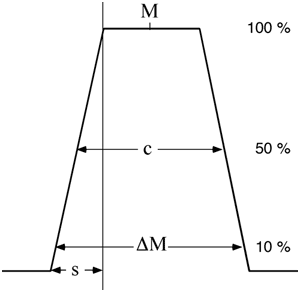Operation - Peak shapes
In mass spectrometry, the optimal peak shape for isotopic ratio measurements
is trapezoidal (see figure). This peak shape is most appropriate because
any small fluctuations in the magnetic field do not cause variations in
the peak intensity. The trapezoidal parameters can be adjusted by changing
the width of the source and collector slits. The FWHM (Full Width at Half Maximum) of the peak reflects
the collector slit width, while the slope on the side of the peak reflects
the image of the source slit through the mass spectrometer. On SHRIMP
II the beam is demagnified with a magnification factor of 0.44 while on
SHRIMP RG it is 0.33. Any beam spread beyond that attributable to the
demagnified source slit image can be attributed to beam aberrations. The
peaks can be transposed between field, mass and geometrical distance through
the mass spectrometer dispersion equation. The mass resolution of the
peaks is expressed at a specified peak height (e.g. at 10 % peak height)
or at a specified valley height (e.g. 1%) between two equal height peaks.
In addition abundance sensitivity can be expressed as a function of signal
level to peak height at a specified mass difference from a peak (e.g.
unity mass separation from U-238 or Ca-40 are commonly used).

Trapezoidal peak shape is defined by the collector slit (c) and demagnified source slit (s) widths. Mass resolution is defined as M/ΔM
 menu
menu